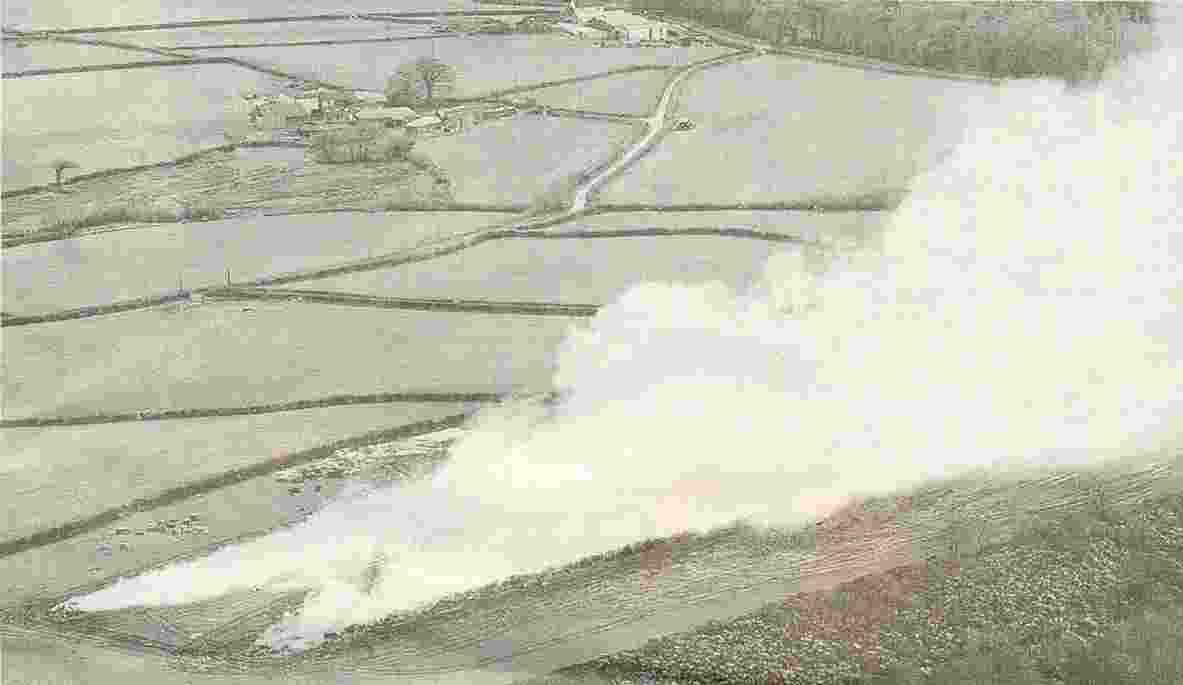
Bridestowe, Near Okehampton, Devon.
Smoke from burning pyres ‘will kill humans’
EXCLUSIVE: Official report reveals risk to old and asthmatics is as bad as killer smog
Sunday Mail 29 April, 2001
THE devastating health risks posed by foot-and-mouth funeral pyres have been outlined in a Government report.
The damning document warns that toxins from the burning carcasses have the potential to cause death and illness among people living nearby.
A team of 19 Government scientists have discovered that pollution levels in some areas are three times higher than during the winter of 1991 when a, smog which enveloped London, was linked to 160 deaths in just four days. The report and risk assessment — described as ‘chilling’ by one environmental agency — was not officially announced by the Government. Instead, The Mail on Sunday can reveal, it appears to have been played down and was only posted on the Internet on a page which is difficult to access.
Jointly prepared by Government agencies, including the Department of Health — the report suggests, belatedly say critics, that asthmatics should be publicly warned in advance before pyres are lit. They should also carry at all times sufficient medication to help with breathing difficulties.
The experts note that ‘non-asthmatic individuals’ were unlikely to be affected at distances of more than 4km from fires.
Although in the worst affected areas, many people live within 4km of some of the biggest pyres.
But they warn that ‘at distances of less than about 2km from the pyre, concentrations are very much higher and sufficient to produce effects on lung function in normal subjects’.
Yesterday the effects of the pyres on thousands of people across Britain were all too apparent. Two huge fires were burning a few miles from Okehampton, population 7,000, on the edge of Dartmoor.
From the air it was clear that the prevailing westerly wind was blowing the choking smoke directly towards the town. And in Okehampton itself, the stench from the fires caused people to cough and rush indoors.
‘It’s terrible, I haven’t stopped coughing all morning,’ said Jane Matthews who was shopping in the main street. ‘No one warns us that the smoke is going to be coming our way. I have no idea what it means for our health.’
James Kinglsey, 54, a garage worker, said he did not know that the smoke would reach as far as the town. ‘It is quite disgusting, I’m wheezing today,’ he said.
In Bridestowe, Devon, its 250 residents were yesterday engulfed in smoke from a new pyre lit on Friday night about two miles from the centre of the village. Meanwhile the residents of Holsworthy, which has a population of 4,000, have been lucky so far that the wind has been blowing the smoke away from the centre of their town. But worryingly, the pyre is less than 4km away. One local GP, who did not wish to be named, said he had seen an increase in coughing and wheezing among patients in the last few days.
Nearby Chuimleigh with 300 residents is waiting for a large pyre to be lit this weekend. Again it is less than 4km away. And villagers living near a mass burial site at Lillyhall, Cumbria, could get a reduction in their council tax because of the outbreak. Conservative councillor leader Mike Graham has called for a 50 per cent cut claiming the smell is a health hazard and is putting people off moving to the area.
Across the north Devon landscape the scars of numerous pyres that have now died down are a horrible reminder that people in this area have been putting up with the smoke and its dangers for many weeks now.
Locals are also worried about the huge number of carcasses left rotting for the last two weeks.
Already, health experts have been
called in to monitor people living near the pyres after doctors in Devon, Cumbria and the North East reported a dramatic increase in the number of patients complaining of breathing difficulties and respiratory illness.
In some cases, according to the report, continual burning could shorten the lives of anyone suffering from heart or lung complaints. The effects would be seen in months rather than years.
The report also warns that the pollutants, including cancer causing dioxins, released into the atmosphere will contaminate plants and vegetables. Department of Health chiefs yesterday circulated warnings that all vegetables close to pyres should be washed thoroughly and outer leaves stripped before use.
Officials from the Food Standards Agency will monitor the soil around the main burning sites. And the study group recommends that health surveillance works should be carried out in areas adjacent to the pyres.
Last night, Friends of the Earth said the risk assessment was chilling and accused the Government of doing its best to ignore it.
‘The plain fact is that it has been issued after the damage is done,’ said a spokesman. ‘We have polluted and continue to pollute the areas around all these burning pyres and the long term effect on health could be very serious indeed.
‘Their own experts conclude that mistakes have already been made in the use of some materials. We cannot understand why the Government gave permission for pyres to be lit before the risk assessment was completed. It makes no sense at all.’
Ministers have been at odds over the dangers posed by the pyres. Environment Minister Michael Meacher has conceded that dioxins produced by the fires were ‘a health risk’. His frank admission followed Defence Secretary Geoff Hoon’s assertion that the pollution was equivalent to two Bonfire Nights.

Bridestowe, Near Okehampton, Devon.